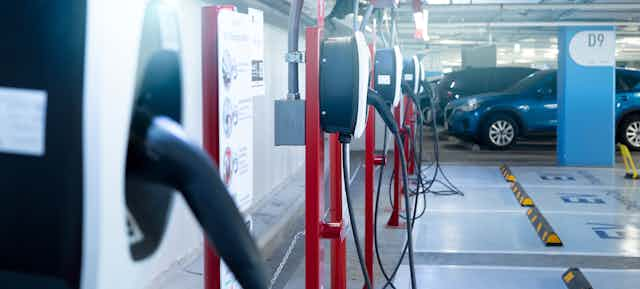Due to the urgent need to cut fossil fuel emissions, the adoption of electric vehicles (EVs) is both inevitable and essential. The EU is aiming to reduce greenhouse gas emissions from transport by 90% by 2040, and foresees 13 million zero and low-emission vehicles on the roads by 2025. Several European countries have introduced their own measures to encourage the uptake of EVs.
Thanks to these policies and rapid technological advancements, electric vehicle sales in Europe surged from 3.2% of the total market share in 2019 to approximately 10% in 2020, according to the International Energy Agency. This upward trajectory is expected to continue, reaching 19% by 2025 and 35% by 2030.
These vehicles, however, are not without risk.
Where is your car right now?
Our towns and cities are designed around roads which were built for cars, but according to some estimates these vehicles in fact spend around 95% of their time in the garage.
This presents a new series of safety challenges: studies indicate that the batteries in electric vehicles carry the risks of thermal runaway, a phenomenon which can potentially result in sudden, extensive vehicle fires.
The dangers are far from hypothetical: in central Madrid, on 29 August 2023, a plug-in hybrid vehicle caught fire in a busy shopping centre car park on the bustling Paseo de La Castellana. In a similar incident on 25 September 2022, an electric vehicle caught fire in Barcelona, destroying not only itself but also an adjacent vehicle.
While batteries are a significant risk factor, our research has shown that other potential causes of electric vehicle fires include vehicle faults, management factors, human factors, and external factors.
Fire in enclosed spaces
From a fire safety engineering perspective, enclosed spaces such as underground car parks greatly increase the risk of deadly and destructive compartment fires. In these situations the heat and fumes from a fire become trapped, increasing the severity of the fire and its impact on those exposed. Compartment fires also lead to incomplete combustion, releasing large amounts of hazardous gases and extreme heat, which can be lethal in such environments.
As car parks fill up with more and more electric vehicles, these structures become, essentially, large-scale battery storage systems, greatly heightening the risk of fire. The installation of charging stations may further increase the likelihood of a blaze.

National regulations present a roadblock
Though the uptake of electric vehicles is widespread across all of Europe, approaches to fire safety regulations for new and existing buildings vary considerably among countries. This is due to variations in government structures, legal systems, and the differing roles of public and private sectors within each nation.
Despite these discrepancies, the most pressing concern is the conspicuous lack of specific fire safety regulations for alternative vehicles, including electric vehicles, in some European countries. As of 2020, building codes in several countries – Spain, the Netherlands, and Norway – all lacked specific fire safety design regulations for electric vehicles in car parks.
This absence of specific regulations raises significant questions for the design of both new and existing enclosed car parks. With the incidents in Madrid and Barcelona serving as stark reminders, the need for a comprehensive understanding of the fire risks associated with electric vehicles is becoming increasingly urgent.
The road ahead
A collaborative effort is currently underway to provide such a framework. It involves researchers from the Universidad de Navarra in Spain and Universiti Putra Malaysia, and builds on previous research projects that have focused on vehicle fires in car parks. However, the scope of this topic is vast, meaning many specialised researchers will have to be included over the coming months and years.
The future of sustainable transportation hinges on our ability to understand and mitigate these risks. We not only need specific regulatory frameworks, but also a cohesive Europe-wide strategy to ensure a uniformly high level of safety. Only by making advances in this critical field can we ensure that the transition to electric mobility is safe and beneficial for society as a whole.


